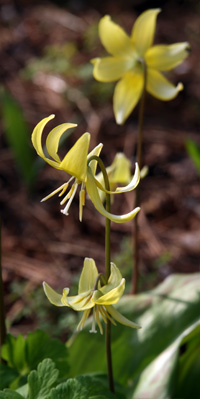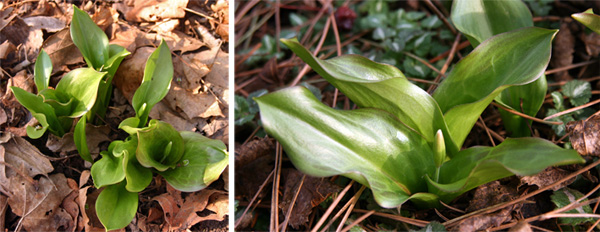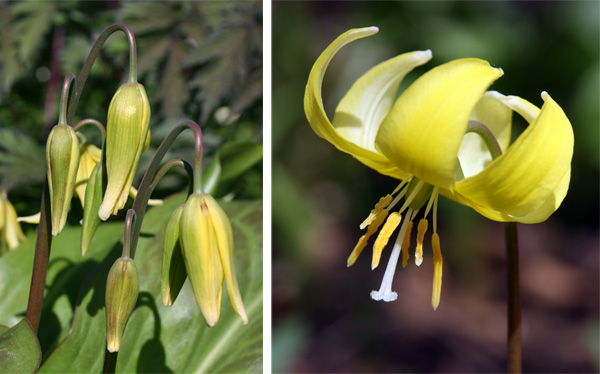
Erythronium is a genus of 20-30 species of bulbs in the lily family (Liliaceae) found in meadows and forests in temperate North America, Europe, and Asia, with most of the species native to western North America. Most of these spring-blooming perennials – commonly called trout lilies or dog-tooth violets – prefer cool, damp climates and dappled shade and many species are difficult to establish and grow outside of their native range. The hybrid called ‘Pagoda’, however, is a vigorous plant that is an outstanding addition to gardens in zones 4-9 (and probably to zone 3 with mulch). It was awarded the Royal Horticultural Society’s Award of Garden Merit in 1993.

This garden ornamental is a cross between E. tuolumnense and E. californicum ‘White Beauty’. E. tuolumnense is found only in Tuolumne County, California where it grows in rich gritty humus in open woodland. It goes dormant during the hot, dry summers there. Its native habitat is threatened by logging. This yellow-flowered species with green leaves that increases by offsets has been used to create many of the garden hybrids. E. californicum comes from moist woodlands in the coastal mountain ranges of northern California. Plants have white flowers marked with a yellow, orange or brown ring near the greenish yellow base. The leaves of young plants are green, but become more mottled in subsequent years. ‘White Beauty’ is a selection from a collection of wild-dug bulbs that offsets more prolifically than most. This selection is considered by some to be a white form of E. revolutum, so that species is occasionally listed as the parent of the hybrid ‘Pagoda’.
‘Pagoda’ trout lily is an attractive plant with deep green, glossy leaves that are mottled with brown, bronze, or maroon markings. The coloration is most conspicuous early in the spring when the leaves first emerge, and tends to fade later in the season. The rosette of leaves grows from long, tooth-like bulbs and dies back soon after the plants finish flowering.

This robust clump-forming hybrid blooms in mid- to late spring, producing 3-5 elegant, lily-like flowers per stem. The wiry stems are 6-12″ long, holding the pendant flowers well above the leaves and often multiple stems are produced from each bulb. The six pale lemon-yellow blooms have recurved, pointed petals and a dark, reddish-brown central ring. Stamens with deep yellow anthers hang down in the center.

‘Pagoda’ trout lily is a nice addition to moist woodland gardens, shady rock gardens and mixed beds. It does best in rich, moisture retentive soil, and needs moist soil even when dormant.

Because it goes dormant after blooming, interplant with late-emerging perennials to fill in the open space. It combines well with bleeding heart, columbine, hosta, ferns and many other ornamentals. This cultivar will naturalize quite easily in a shady garden, along with trilliums, jack-in-the-pulpits, and other native wildflowers.
Trout lily bulbs should be planted in the fall a few inches deep and 1-2″ apart. Keep the bulbs moist until the ground freezes. ‘Pagoda’ trout lily can be propagated by lifting and dividing large clumps when the leaves start to yellow in summer. Because it is a hybrid, it cannot be grown from seed.
Of the many other species of Erythronium, two are native to Wisconsin where they both form dense colonies in moist forests and woods. E. albidum, white trout lily or dog-tooth violet, has 1-2″ long, gleaming white to pinkish flowers with yellow centers blooming in mid- to late-spring.

It is common in southern Wisconsin, while the similar species E. americanum, with a yellow flower, is common in the northern part of the state. There are many more species in western North America – including the parents of ‘Pagoda’ – as well as some from Europe and Asia.

– Susan Mahr, University of Wisconsin – Madison
Latest from Wisconsin Yard & Garden
Ask Your Gardening Question
If you’re unable to find the information you need, please submit your gardening question here:





 Aster, Symphyotrichum spp.
Aster, Symphyotrichum spp. Fascinating Fasciation
Fascinating Fasciation Alternatives to Lawn: Groundcovers
Alternatives to Lawn: Groundcovers Marigolds
Marigolds


